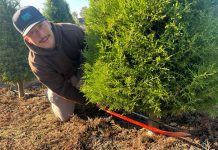California is in the middle of a severe fire season that started early, authorities say.
According to Gilroy Fire Chief Alan Anderson, the weather has been drier this year than past years.
Anderson stated that drying fuel ladders – a firefighting term for live or dead vegetation that allows a fire to climb up from the landscape or forest floor into the tree canopy – are two months ahead of schedule this year.
Fuel ladders, in addition to dry winters, are reliable indicators of when a fire season will start.
“Dry winters indicates a fire season will start much earlier than normal,” Anderson said.
Fire season starts in early May and lasts through the end of October, but depending on the weather, “it could end as late as November,” said CalFire Battalion Chief Brandon Leitzke.
So far this year, there have been 50 vegetation fires in Santa Clara County, and 12 of those have been in Gilroy alone. Anderson said the season has been very active and firefighters can’t predict how the rest will pan out.
“Fires have ranged from small to medium-sized,” he said.
California has already spent $221 million fighting fires this year alone, and costs have risen more than $220 million annually in the past six years, according to information released by the Office of Governor Jerry Brown.
Recently on July 12, multiple crews from CalFire, Morgan Hill Fire and the South County Fire District spent an exhausting Friday afternoon battling blazes that engulfed more than 50 acres of vegetation in west Morgan Hill. That was followed by a long night “mopping up” the area and making sure all remaining hotspots were out, authorities said.
Other major rural burns that happened in the not-too-distant past include the Hummingbird and Whitehurst fires; two catastrophes still emblazoned in the memories of locals who witnessed the damage caused by flames that swept through rural northwest Gilroy in 2008. The Whitehurst Fire gobbled up chunks of thick forested mountainside high up in the Mt. Madonna area west of Gilroy, while the Hummingbird Fire had consumed more than 400 acres in the Hayes Valley area on the north side of the ridge and south of the ridge toward Day Road.
With the lack of rain this season, firefighters are taking every precaution to minimize the risks of something of that scale happening again, familiarizing themselves with tools and techniques to cope with frequent wildfires.
“We are training and taking normal procedures, because it has been a very active fire season,” said Chief Leitzke, underscoring the potential for a “very active” fire season to continue.
This year, the Santa Clara County Fire Chiefs Association held a countywide fire session in Sanborn County Park in Saratoga. The three-day session involved fire departments, law enforcement agencies, County Emergency Services personnel and volunteers.
“We had several crews alternate different sessions,” said Anderson.
Each session dealt with a different scenario such as how to protect a home and handle tools to protect vegetation.
Residents are bracing for the fire season as well.
Morgan Hill locals Roy and Sue Guist are better prepared these days, compared to when the Croy Wildfire consumed their rural home in 2002, along with 3,127 acres on the south face of Bachelor Hill in Uvas Canyon and 31 surrounding residences.
“All our possessions and 50 acres of surrounding land was taken from us in the Croy Wildfire,” Roy, 85, said.
They are following simple rules to keep their home (the couple has since moved from Croy Road and now lives in a Morgan Hill neighborhood) from being exposed to damage. Guist and his wife are keeping a defensible space of 100 feet around their house, which protects their property while providing a safe zone for firefighters if a fire hits.
“There is a lot of indigenous shrub that I have to clear up to reduce the fuel zone,” said Guist.
He is maintaining the vegetation within the defensible space by breaking up and removing dead vegetation. According to Guist, he can’t stop a fire, but what he can do is minimize the damage to his home.
The Santa Clara County FireSafe Council is huge resource for residents on how they can be prepared for wildfires. The council meets monthly to bring residents and organizations together to address wildfire concerns in South County.
Director Jenn Viane Riese with the FireSafe Council has been raising funds through fundraising drives for services that were typically free to the public.
“We are encouraging residents to download ‘Living With Fire’ from our website, which is a homeowners guide to creating and maintaining defensible space,” said Riese.
These tips, she said, help residents be fire-safe and drought-tolerant as they fire-proof their home and create “defensible space.” This is “essential to improve your home’s chance of surviving a wildfire,” according to CalFire. “It’s the buffer you create between a building on your property and the grass, trees, shrubs or any wildland area that surround it. This space is needed to slow or stop the spread of wildfire and it protects your home from catching fire – either from direct flame contact or radiant heat. Defensible space is also important for the protection of the firefighters defending your home.”
Creating defensible space entails reducing and removing dry bush and overhanging limbs surrounding a home.
“County Fire and County Weed Abatement have sent out their brush clearance notices to homeowners in WUI [Wildland Urban Interface] areas,” Riese reminded.
Local fire agencies will do a property walk-through if residents have concerns. PG&E also lends a hand by doing power line inspections to make sure tree limbs are a safe distance from power lines.
“Lastly, it’s about being smart – no fireworks, no burning, no operating equipment near or around dry brush,” said Riese. “The South County FireSafe Council is an excellent way to get connected.”










